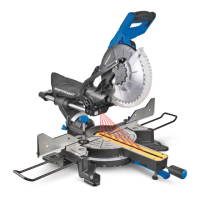26 27
model no. 055-6745-2 | contact us 1-800-689-9928
wood fence can be mounted to your saw. Holes are provided in the saw fence to attach an auxiliary
wood fence (this provides additional depth of cut). This fence should be constructed of straight
auxiliary wood approximately 3/4” (1.9 cm) thick by 3” (7.6 cm) high by 19” (48.3 cm) long. Attach
the wood fence securely and make a full depth cut to make a blade slot. Check for interference
between the wood fence and the lower blade guard. Adjust if necessary.
CUTTING BASE MOULDING
Base mouldings and many other mouldings can be cut
on a compound mitre saw. The setup of the saw depends
on moulding characteristics and applications, as shown.
Perform practice cuts on scrap material to achieve best
results:
• Always make sure mouldings rest firmly against
the fence and table. Use hold-down or C-clamps,
whenever possible, and place tape on the area being
clamped to avoid marks.
• Reduce splintering by taping the cut area prior to
making cut. Mark cut line directly on the tape.
• Splintering typically happens due to wrong blade
application and thinness of the material.
CUTTING CROWN MOULDING (Fig. 29, 30)
Your compound mitre saw is suited for the difcult task of
cutting crown moulding. To t properly, crown moulding
must be compound-mitreed with extreme accuracy. The
two surfaces on a piece of crown moulding that t at
against the ceiling and wall are at angles that, when added
together, equal exactly 90°.
Most crown moulding has a top rear angle (the section that
ts at against the ceiling) of 52° and a bottom rear angle
(the section that ts at against the wall) of 38°.
In order to accurately cut crown moulding for a 90° inside
or outside corner, lay the moulding with its broad back surface at on the saw table. When setting
the bevel and mitre angles for compound mitres, remember the settings are interdependent;
changing one changes the other, as well.
OPERATING INSTRUCTIONS
OPERATING INSTRUCTIONS
Bevel/Mitre Settings (when the angle between the walls equals 90°)
Inside corner - Left side
IL 33.9° 31.6° Right 1. Position top of moulding against fence.
2. Mitre table set at RIGHT 31.6°.
3. LEFT side is finished piece.
Inside corner - Right side
IR 33.9° 31.6° Left 1. Position bottom of moulding against
fence.
2. Mitre table set at LEFT 31.6°.
3. LEFT side is finished piece.
Outside corner - Left side
OL 33.9° 31.6° Left 1. Position bottom of moulding against
fence.
2. Mitre table set at LEFT 31.6°.
3. RIGHT side is finished piece.
Outside corner - Right side
OR 33.9° 31.6° Right 1. Position top of moulding against fence.
2. Mitre table set at RIGHT 31.6°.
3. RIGHT side is finished piece.
IL
IR
OL
OR
Inside
Corner
Outside
Corner
Fence
Mitre saw table
Workpiece
Fence
Mitre saw table
Workpiece
Fence
Mitre saw table
Workpiece
Mitre at 45°
bevel at 0°
Fence
Mitre saw table
Mitre at 0°
bevel at 45°
Workpiece

